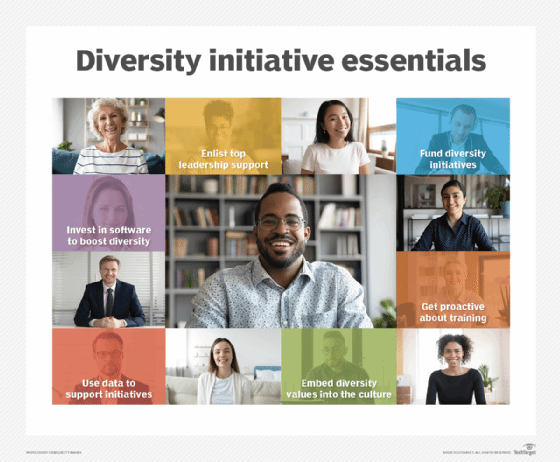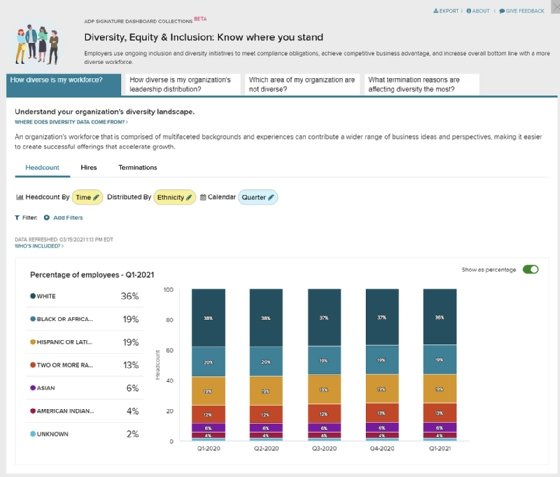cognitive diversity
What is cognitive diversity?
Cognitive diversity is the inclusion of people who have different styles of problem-solving and can offer unique perspectives because they think differently, have divergent perspectives and come from varied backgrounds. Discussions about cognitive diversity are common in organizations, particularly those serious about promoting workplace diversity, equity and inclusion (DEI).

Also known as diversity of thought, cognitive diversity refers to the different ways in which people think. A cognitively diverse workforce brings many distinct viewpoints and its members make decisions in dissimilar ways, bringing better problem-solving abilities to the organization.
Unlike demographic diversity, which focuses on achieving a mixture of statistical characteristics such as gender or age, cognitive diversity focuses on blending how people carry out intellectual activities, such as making associations or drawing conclusions.
The issues with a cognitively uniform workplace
A workplace can become cognitively uniform for several reasons. For example, it could be because of the following:
- Someone in the C-suite prefers candidates who graduated from a particular school or are most likely to be a "culture-fit."
- A mid-level manager feels compelled to fill an open position with someone who has the same experience as the employee who left.
The tendency for an employer to look for someone who conforms with the employer's existing beliefs is called confirmation bias. Bias is one of the most common issues in a cognitively uniform workplace. Whether it appears consciously or unconsciously, bias can lead to groupthink, the practice of discouraging individual creativity or responsibility, often to avoid conflict. Bias and groupthink deter people with different ideas or perspectives from speaking up and contributing their unique ideas. This usually occurs because those with disparate views fear a lack of acceptance from colleagues and managers, and, in the worst cases, worry about reprisals and punishments.
A cognitively uniform workplace tends to struggle with problem-solving and decision-making. Such organizations often have inefficient processes and employees that resist changes and cope poorly with disruptions.
Importance of cognitive diversity in the workplace
For organizations, a significant benefit of increasing cognitive diversity is that it can reduce and even eliminate bias. Bringing in team members with dissimilar ways of thinking promotes diversity of thought while encouraging individual responsibility and accountability. Some companies benefit from using software that can help them track their DEI performance.

Diversity of thought is often considered important to a successful workplace. People who bring unique perspectives might see threats or opportunities others miss. This chemistry of human interaction is a critical component of innovation.
Researchers have observed patterns in how people process information and collaborate with others. Some prefer to apply existing information to new challenges, while others generate new knowledge. People vary in their tendency to apply their own expertise versus calling on others. Teams with more diverse approaches at their disposal have been shown to be more creative and perform better.
Diverse teams bring more skills and perspectives to the organization. They are more cohesive and can work off of each other's skills and perspectives. They can think creatively and collaborate better to come up with new ideas and solutions.
Cognitive diversity also enriches a company's culture; it promotes empathy, teamwork, experimentation and a blameless culture. Deliberately diverse organizations promote creative thinking. Employees are encouraged to suggest new ideas and support colleagues whose ideas differ from their own. Any company can be deliberately diverse but achieving that goal is not a trivial pursuit.
What do cognitively diverse teams look like?
In a cognitively diverse team, members who may be from varied ethnicities or cultural backgrounds are not afraid to think differently from others or to convey their different ideas. Some members may be from an individualistic culture that prioritizes the needs of individuals over the needs of a group. Other members may be from a collectivist culture where a group's needs are considered more important than an individual's. Either way, in a cognitively diverse team, these cultural differences are embraced rather than ridiculed, promoting diversity of thought, actions and decisions.
Members' educational and socio-economic backgrounds and previous work experience can also impact a team's diversity. These factors can be influential in why people think and learn differently, study varied things and have unique experiences. These factors result in varied approaches to problem solving as well as unique skills and ideas that can help the company.
Strategies to boost cognitive diversity in the workplace
One way to foster cognitive diversity in the workplace is to hire individuals who have the required skills and competencies, instead of looking for workers who fit a particular cultural or educational "mold." Hiring managers should look for candidates who bring in new perspectives and can add these perspectives to the company culture, even if they don't necessarily "fit" the culture.
It's also important to create a safe environment where employees can openly share their ideas and perspectives without fear of reprisals. Providing them with training and learning opportunities also encourages new ways of thought and allows more innovative ideas to emerge and flourish.
Explore 20 diversity and inclusion tools to power your diversity, equity and inclusion program and 5 benefits of developing diversity in customer service.





